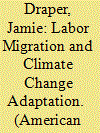|
|
|
Sort Order |
|
|
|
Items / Page
|
|
|
|
|
|
|
| Srl | Item |
| 1 |
ID:
174851


|
|
|
|
|
| Summary/Abstract |
Although adaptation to climate change is becoming increasingly recognised as an unavoidable priority, barriers are consistently encountered and reported. Identifying, analysing and overcoming these barriers is essential for ensuring that, as climate change worsens, adaptation capacities are not exceeded. Despite current studies providing a useful structuring heuristic to guide inquiry, there is a significant gap related to explanations around barrier occurrence and how to overcome them. In response, this article, based on semi‐structured stakeholder interviews, aims to provide preliminary insights into the type of barriers that exist in Laamu Atoll, the Maldives and explore any interdependencies between them. This study found that a range of resource barriers (i.e. funding, physical and human resources in outer islands and data on vulnerable groups) and social barriers (i.e. political/institutional and organisational constraints and inefficiencies, marginalisation and power differences as well as cognitive elements) were hampering adaptation. In exploring the interdependencies that exist between these barriers, the nature of their occurrence, persistence and entry points for resolution were also identified.
|
|
|
|
|
|
|
|
|
|
|
|
|
|
|
|
| 2 |
ID:
116765


|
|
|
|
|
| Publication |
2012.
|
| Summary/Abstract |
This communication discusses climate change adaptation efforts underway in Vanuatu. In particular, it uncovers why community-based approaches to adaptation are more likely to bear fruit than ones driven from the top-down at the national level. The authors make this claim based on early evidence that small-scale projects (a) support community ownership over adaptation, (b) provide ongoing technical learning lessons (c) relieve pressure from capacity constraints at national administrative bodies, and (d) expedite implementation by avoiding cumbersome multilateral procedures. The first section discusses its research methods and presents important characteristics of the Vanuatu economy, people and geography. The communication then moves on to discuss Vanuatu's vulnerability to the effects of climate change. It specifically investigates on-going efforts to adapt to natural climatic hazards in Vanuatu. Early evidence and analysis reveals lessons salient for energy and climate policy.
|
|
|
|
|
|
|
|
|
|
|
|
|
|
|
|
| 3 |
ID:
170224


|
|
|
|
|
| Summary/Abstract |
The Indian Ocean contains one of the busiest trade routes in history, connecting East Asia, Southeast Asia, South Asia, the Middle East, and East Africa, as well as giving passage to Europe. Given its historical and economic connections and diffusion of ideas, religions, and cultural traditions, the Indian Ocean region's (IOR) fertile cultural complex can serve as an important platform for addressing climate change. In order to survive and thrive under climate change, societies in the IOR need to undergo profound transformation or metamorphosis. We briefly discuss the history and major climate change issues of the IOR before proposing five suggestions: engaging in regional cooperation on climate change; combining the region's folk science and indigenous traditions with modern science and technology in the formulation and implementation of climate strategies; embracing the region's terraqueous geography; initiating development corridors inland; and ensuring that cities and urban development are sustainable and liveable.
|
|
|
|
|
|
|
|
|
|
|
|
|
|
|
|
| 4 |
ID:
173468


|
|
|
|
|
| Summary/Abstract |
The share of climate related disasters in the total disaster events have been increasing steadily. The unprecedented impact of extreme temperature events in Europe and sudden increase in the flood events in rest of the world is strongly linked with climate change patterns. The most devastating impact of climate change involves making the weather pattern erratic.
|
|
|
|
|
|
|
|
|
|
|
|
|
|
|
|
| 5 |
ID:
173816


|
|
|
|
|
| Summary/Abstract |
The Indian Ocean contains one of the busiest trade routes in history, connecting East Asia, Southeast Asia, South Asia, the Middle East, and East Africa, as well as giving passage to Europe. Given its historical and economic connections and diffusion of ideas, religions, and cultural traditions, the Indian Ocean region's (IOR) fertile cultural complex can serve as an important platform for addressing climate change. In order to survive and thrive under climate change, societies in the IOR need to undergo profound transformation or metamorphosis. We briefly discuss the history and major climate change issues of the IOR before proposing five suggestions: engaging in regional cooperation on climate change; combining the region's folk science and indigenous traditions with modern science and technology in the formulation and implementation of climate strategies; embracing the region's terraqueous geography; initiating development corridors inland; and ensuring that cities and urban development are sustainable and liveable.
|
|
|
|
|
|
|
|
|
|
|
|
|
|
|
|
| 6 |
ID:
155571


|
|
|
|
|
| Summary/Abstract |
Northern Russia’s physical vulnerability to climate change is at best severe, considering the underlying permafrost and the threat that warming presents to that foundation.” Second in a series on climate adaptation around the world.
|
|
|
|
|
|
|
|
|
|
|
|
|
|
|
|
| 7 |
ID:
192802


|
|
|
|
|
| Summary/Abstract |
Transitioning to an equitable electricity sector requires a deep understanding of a warming climate's impacts on vulnerable populations. A vital climate adaptation measure is deploying air-conditioning (AC), but AC use can increase household energy costs. We evaluate how a warming climate will affect regional energy equity by tying temperature projections with household temperature response functions derived from smart-meter electricity data in Phoenix, Arizona. We simulate future consumption changes under two climate change scenarios from 2020 to 2070, with and without AC efficiency upgrades.
|
|
|
|
|
|
|
|
|
|
|
|
|
|
|
|
| 8 |
ID:
101404


|
|
|
|
|
| Publication |
2011.
|
| Summary/Abstract |
Many policy-makers view nuclear power as a mitigation for climate change. Efforts to mitigate and adapt to climate change, however, interact with existing and new nuclear power plants, and these installations must contend with dilemmas between adaptation and mitigation. This paper develops five criteria to assess the adaptation-mitigation dilemma on two major points: (1) the ability of nuclear power to adapt to climate change and (2) the potential for nuclear power operation to hinder climate change adaptation. Sea level rise models for nine coastal sites in the United States, a review of US Nuclear Regulatory Commission documents, and reports from France's nuclear regulatory agency provided insights into issues that have arisen from sea level rise, shoreline erosion, coastal storms, floods, and heat waves. Applying the criteria to inland and coastal nuclear power plants reveals several weaknesses. Safety stands out as the primary concern at coastal locations, while inland locations encounter greater problems with interrupted operation. Adapting nuclear power to climate change entails either increased expenses for construction and operation or incurs significant costs to the environment and public health and welfare. Mere absence of greenhouse gas emissions is not sufficient to assess nuclear power as a mitigation for climate change.
|
|
|
|
|
|
|
|
|
|
|
|
|
|
|
|
| 9 |
ID:
193200


|
|
|
|
|
| Summary/Abstract |
This article probes the rural economic development approach in selected informal settlements in Durban and how such approach affects the vulnerability of local Black women to flood impacts within the areas. Qualitative data for the study were gathered through semi-structured interviews and focus group discussions with 25 local Black women from Inanda, Ntuzuma, KwaMashu and Umlazi. Five key informants from the eThekwini (Durban) metropolitan municipality were also interviewed. Findings from the study showed that although there is improved economic development in the selected settlements, which constitute informal settlements designated for Black South Africans during the apartheid era, such an economic development approach has not significantly improved the livelihoods and adaptive capacity of the local women. The article suggests a multidimensional approach to development that is practical, inclusive and equitable, and addresses local women’s challenges associated with climate adaptation and sustainable livelihoods.
|
|
|
|
|
|
|
|
|
|
|
|
|
|
|
|
| 10 |
ID:
150451


|
|
|
|
|
| Summary/Abstract |
Electricity is becoming ever more central to the everyday practices of households. As the energy system decarbonises, it is likely that electricity will supply even more services, thereby increasing the dependence of communities on reliable electricity supply. In this situation, the risk of power outages during extreme weather events poses a serious challenge to the safety and wellbeing of communities. However, little is known of the capacity of households to manage normal day-to-day life in such circumstances. This paper focuses on the UK winter storms that occurred in February 2014, the result of which 80,000 homes were left without power and communities not reconnected for several days. We outline the impacts these power outages had on households, describing the challenges faced and the strategies adopted to alleviate impacts. This provides insight into everyday household-level resilience achieved through social and material elements that constitute everyday life.
|
|
|
|
|
|
|
|
|
|
|
|
|
|
|
|
| 11 |
ID:
186696


|
|
|
|
|
| Summary/Abstract |
Social scientific evidence suggests that labor migration can increase resilience to climate change. For that reason, some have recently advocated using labor migration policy as a tool for climate adaptation. This paper engages with the normative question of whether, and under what conditions, states may permissibly use labor migration policy as a tool for climate adaptation. I argue that states may use labor migration policy as a tool for climate adaptation and may even have a duty to do so, subject to two moral constraints. First, states must also provide acceptable alternative options for adaptation so that the vulnerable are not forced to sacrifice their morally important interests in being able to remain where they are. Second, states may not impose restrictive terms on labor migrants to make accepting greater numbers less costly for themselves because doing so unfairly shifts the costs of adaptation onto the most vulnerable.
|
|
|
|
|
|
|
|
|
|
|
|
|
|
|
|
| 12 |
ID:
183931


|
|
|
|
|
| Summary/Abstract |
Drawing on field research across four years, this article examines a climate change adaptation project in the Cambodian highlands. It examines the logic and rationality of making vulnerable groups resilient in the context of climate change. It shows how adaption projects tend to understand vulnerability as the result of a series of external threats that arise due to global climate change and are expressed primarily as lost income. Using the example of Knaing village in Mondolkiri province this article shows that when it comes to vulnerability, it is often unhelpful to separate between capitalist relations, state territorialization and climate change. Economic, political, and cultural relations that people in the village find themselves imbedded in are co-produced through the interaction of climatic forces, the expansion of capitalist relations and state territorialization. This article thus tries to sketch out a conception of vulnerability based on villager’s changing agricultural practices and livelihood trajectories in the context of the expansion of Economic Land Concessions, logging of surrounding forests, and settlement of adjacent lands and state conservation efforts.
|
|
|
|
|
|
|
|
|
|
|
|
|
|
|
|
|
|
|
|
|